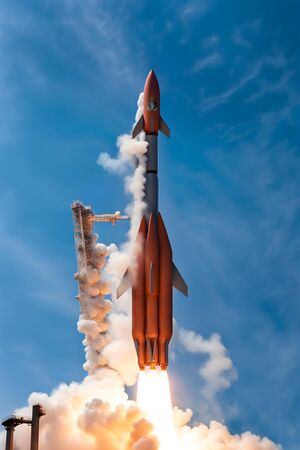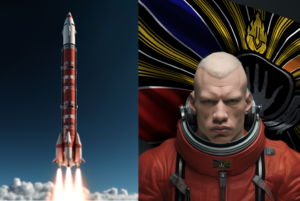Hergom in Space: Difference between revisions
| Line 28: | Line 28: | ||
== H1sterdhomos space station == | == H1sterdhomos space station == | ||
[[File:Spacestation.png|thumb|300x300px|The H1sterdhomos space station on orbit above the Stolvic ocean.]] | [[File:Spacestation.png|thumb|300x300px|The H1sterdhomos space station on orbit above the Stolvic ocean.]] | ||
[[File:Rect16992.png|left|thumb|974x974px|H1sterdhomos space station module plan]] | |||
[[category:Hergom]][[category:Science]] | [[category:Hergom]][[category:Science]] | ||
Revision as of 08:43, 25 December 2023

The Wolgos space program traces its origins back to the year 7669 when it emerged as an integral part of the Wolgos government's broader efforts in nuclear weapons development. Initially, the primary objective of the rocketry program was to design and develop launch vehicles tailored for the delivery of nuclear warheads. Rockets were instrumental in this context, representing a critical component of the nation's strategic offensive capabilities. As negotiations with the International Consortium of Nations (ICoN) progressed, global long-range delivery methods for nuclear warheads were established, rendering the program's initial purpose somewhat obsolete.
In light of these geopolitical developments and the evolving landscape of international diplomacy, the Wolgos rocketry program underwent a significant transformation. Scientific and prestigious aspirations began to take centre stage, redirecting the program's focus from military applications to peaceful exploration and discovery. By the year 7675, the Wolgos Intercontinental Ballistic Missile (ICBM) program had already started winding down, and expectations of its eventual shelving grew as ICoN sanctions were gradually relaxed.
The turning point arrived in 7676 when the program underwent a complete overhaul and repurposing. It transitioned from being under military jurisdiction to becoming the responsibility of a newly established agency. This transformation allowed the program to diversify its personnel, welcoming not only engineers and technicians but also doctors, scientists, and astronomers into its ranks. This expanded and interdisciplinary team marked the beginning of a new era for the Wolgos space program, one that was characterized by a commitment to scientific exploration, international cooperation, and the advancement of knowledge beyond the boundaries of Gotha's atmosphere.
H1stērh1eukmnt

H1stērh1eukmnt (Stellar Directive), the governing agency of the Wolgos space program, stands as a symbol of unity and exploration in Hergom. This government agency operates with the full backing of Hergom's central authority while collaborating with tribal enterprises, serving as contractors and suppliers in a joint mission of cosmic exploration and scientific discovery.
The agency's primary facilities are located in the tropical haven of Dharmnghel, nestled in the northernmost Aleutian Peninsula coastal plains. Here, under warm tropical skies and occasional seasonal tropical storms, the agency conducts its ground breaking work. Politically, Dharmnghel falls within the Gahnam autonomous zones, yet the territory hosting the agency's activities has been officially designated as part of Hergom's capital territory, reflecting its exceptional significance.
Wolnauts, the intrepid individuals who venture into the cosmos, are recruited predominantly from the ranks of the Hergom Airforce. On certain occasions, the agency may extend invitations to civilian scientists affiliated with esteemed higher education programs. While the agency has welcomed representatives from friendly nations into space, its core focus remains on advancing Hergom's and the Wolgos capabilities in the realm of astronomy and exploration.
It is important to delineate between the agency's esteemed Wolnauts and experimental Eokoesr test subjects. While both contribute to scientific progress, only the former hold the esteemed title of Wolnauts as defined by the agency.
The agency's current mission is a resolute one: to elevate Hergom's prominence in the field of astronomy. This expansive endeavour encompasses weather monitoring, geoscience, astrobiology, astrophysics, and the exploration of our solar system through the deployment of space probes. Equally vital is the agency's commitment to maintaining a continuous presence of Wolgos representatives in the celestial orbit of Gotha, a beacon of Hergom's enduring legacy in the cosmos.
First Wolgos in Space

Bhroghus H2erkusonos, of the Lēudherorēgs tribe, etched his name into history as the very first Wolgos to journey beyond the bounds of Earth's atmosphere. In the southern spring of the year 7679, at the age of thirty-two, Bhroghus embarked on this remarkable adventure, marking the pinnacle of his career. His selection was the culmination of a rigorous process, competing with a select group of pilots from the nation's airforce. Testing, training, and conditioning prepared him for the challenges that lay ahead.
Bhroghus's orbital voyage around Gotha spanned three awe-inspiring hours. During this momentous journey, he undertook a seven-minute spacewalk outside his capsule—an endeavour considered audacious for a maiden flight. The decision to include a spacewalk was made under the weight of political expectations, despite concerns about its timing and necessity.
The H1trebhghentrom (Slingshot) rocket, an adapted variant of the H1ghn̥h1teghosweiks (Righteous Flame) Intercontinental Ballistic Missile (ICBM), served as Bhroghus's vessel for this historic mission. Measuring 25 meters in length, this modified rocket possessed the capability to transport 2,200 kg into Low Gotha Orbit (LGO). The aftermath of the non-proliferation treaty had left Hergom with a surplus of non-deployable ICBMs, which found new purpose under the skilled hands of H1stērh1eukmnt. The agency designed and manufactured both a passenger capsule and a satellite delivery capsule, heralding an era of space exploration.
The inaugural H1trebhghentrom rocket launches featured immobilized and often sedated Eokoesr as test subjects. The first launch encountered failure halfway to LGO, while the second reached LGO but resulted in the Eokoesr's demise due to a heart attack brought by panic during the launch. The third launch, however, proved to be the charm—a successful ascent followed by the euthanasia of the Eokoesr via a pre-programmed mechanism before re-entry. The Wolgos chose this path for ideological reasons, deeming it a matter of prestige not to allow their test subjects to return alive to Gotha. The fifth H1trebhghentrom launch, carrying Bhroghus on board, charted a triumphant course to LGO and safely returned to Earth, culminating in a splashdown near the Hewpes Islands. This historic achievement marked the dawn of Wolgos space exploration and a legacy that would inspire generations to come.
H1sterdhomos space station

